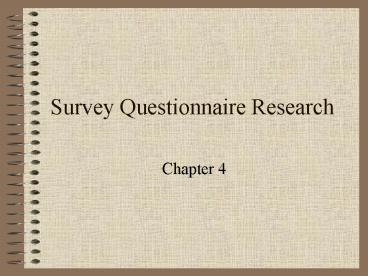Survey Questionnaire Research - PowerPoint PPT Presentation
1 / 12
Title:
Survey Questionnaire Research
Description:
Survey researchers draw conclusions by asking people questions about their ... Survey Questions. Need to be clear and unambiguous ... – PowerPoint PPT presentation
Number of Views:73
Avg rating:3.0/5.0
Title: Survey Questionnaire Research
1
Survey Questionnaire Research
- Chapter 4
2
Introduction to the Method
Survey researchers draw conclusions by asking
people questions about their attitudes and
behaviors.
The questions asked are central to the
method--the questions should produce reliable
(consistent) answers.
The questions should produce valid answers
(respondents must interpret the question the same
way and answer accurately).
3
Survey Questions
Need to be clear and unambiguous
Need to be phrased with the level of measurement
in mind
- nominal
- ordinal
- interval
- ratio
4
Levels of Measurement
- Nominal
- Mutually exclusive, symbolic categories
- E.g., candidate X or Y
- Male or Female
- Ordinal
- Ss rank a variable along some dimension
- E.g., rank group members on leadership, from
highest to lowest
5
Levels of Measurement
- Interval
- A variable measure on a numerical scale, where
the distance between the points on the scale are
equal - its hard to find good examples from
questionnaire research - Ratio
- Similar to interval measurement except ratio
measurements possess an absolute zero point,
i.e., not an arbitrary zero point, as with the
freezing point height has an absolute zero point
6
Types of Questions
- Closed
- closed questions ask Ss to choose between
specified answers - E.g., Yes or No
- Open
- open questions allow Ss to answer in their own
words
7
Sequencing of Questions
- Researchers must decide on the sequencing of
questions, called the - the tunnel
- similarly organized questions
- the funnel
- starts with broad based, open questions, followed
by narrower, closed questions - the inverted funnel
- begins with narrow, closed questions and builds
to broader, open questions
8
Response Set
- Researchers must be wary of response set
- when questions are worded in the same direction
or polarity and Ss choose only one end of the
scale (p. 94)
9
Questionnaire Administration Procedures
- Researcher-administered
- Self-administered
- Single or Multiple Administration
- cross-sectional
- at one point in time
- longitudinal
- administered more than once
10
Response Rate
- The response rate
- the number of usable questionnaires or interviews
divided by the total number of people sampled
usable respondents / total sampled
11
Choosing Survey Questionnaires or Interviews
Who are you questioning? Do they have sufficient
reading and writing skills? Will they respond?
Questionnaires lend themselves to closed
questions and interviews lend themselves to open
questions
Questionnaires are more suitable for studying
sensitive topics
Response rate is higher for interviews than
mailed questionnaires
What resources do you have time, costs,
facilities
12
Lets Work on the Study, Do Workers Trust Labor
Unions and Their Messages? (pp. 98-121)
Work in small groups and prepare (1) a brief
summary of the study (2) an analysis of each of
the following quality of the questions
(clarity) level of measurement sequencing re
sponse set response rate































